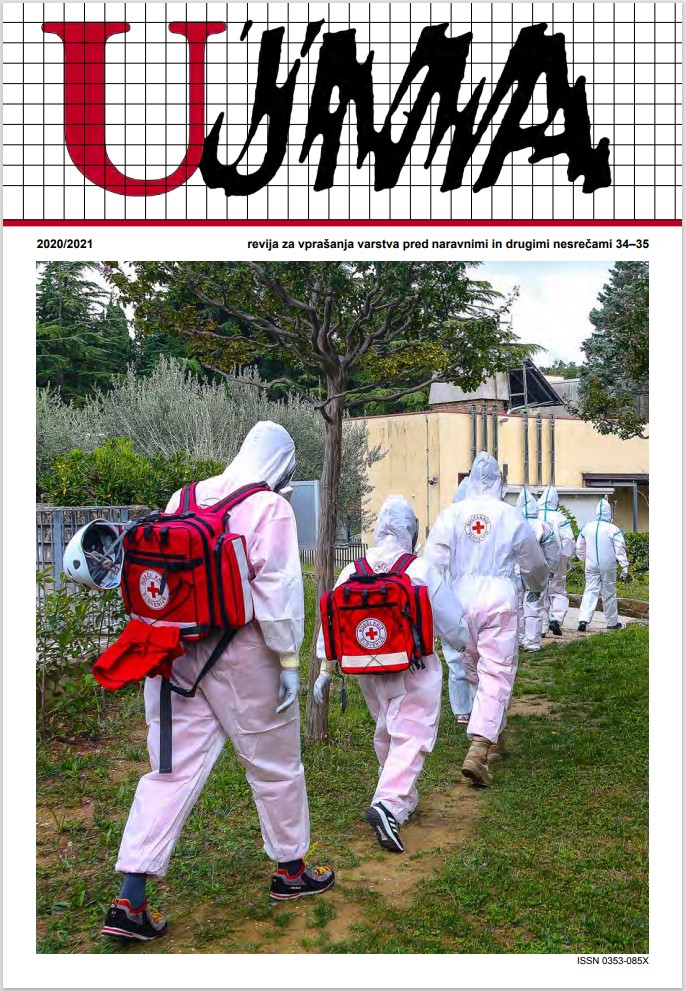PREDICTION USING ARTIFICAL INTELLIGENCE
Abstract
The aim of this study was to create two mathematical forecasting models for management decisions based on intelligent, quantitative analyses. It deals with the field of predicting the number of intervention events of the Maribor Fire Brigade with the help of artificial intelligence. Learning data sets were obtained from the SPIN and ARSO databases, processed in the Python programming language, and then the prediction models were programmed in the MATLAB software package. The aim of the task was to train the artificial neural networks LSTM and NARX to predict events, and to compare their results with each other through metrics for estimating accuracy. The prediction results of some of the learning sets were poor due to small correlations, so we could not predict those events. Fire interventions and natural disasters gave good enough results of correlation analyses, so they were used in the construction of neural networks. Based on the results of the collected models, we believe that neural networks are suitable for predicting intervention events.
References
Agencija RS za okolje, Arhiv meteoroloških podatkov Agencije RS za okolje. https://meteo.arso.gov.si/met/sl/archive/.
Bernico, M., 2008. Deep Learning Quick Reference: Useful hacks for training and optimizing deep neural networks with TensorFlow and Keras. Birmingham: Packt Publishing.
Diaconescu, E., 2008. The use of NARX Neural Networks to predict Chaotic Time Series. Researchgate. https://www.researchgate.net/publication/228571349_The_use_of_NARX_neural_networks_to_predict_chaotic_time_series, 12. 6. 2020.
Géron, A., 2019. Hands-On Machine Learning with Scikit-Learn, Keras, and TensorFlow: Concepts, Tools and Techniques to Build Inteligent Systems, 2. izdaja. Sebastopol: O‘Reilly Media, Inc, USA.
Hochreiter, S., Schmidhuber, J., 1997. Long short-term memory, Neural Computation, let. 9, št. 8, str. 1735–1780.
Hudson, B., Demuth, H., 2004. Neural Network Toolbox User‘s Guide. The MathWorks inc. https://www.google.com/url?sa=t&rct=j&q=&esrc=s&source=web&cd=&cad=rja&uact=8&ved=2ahUKEwj0r8vog77rAhUHtosKHRo6Cv8QFjABegQIBRAB&url=http%3A%2F%2Fcda.psych.uiuc.edu%2Fmatlab_pdf%2Fnnet.pdf&usg=AOvVaw2J9KviZGU6yuCxHpP9GUlb, 15. 7. 2020.
Koloğlu, Y., Birinci, H., Kanalmaz, S. I., Özyılmaz, B., 2018. A Multiple Linear Regression Approach For Estimating the Market Value of Football Players in Forward Position, Abdullah Gül University Industrial Engineering Department.
Marquardt, D., 2012. An Algorithm for Least-Squares Estimation of Nonlinear Parameters, SIAM Journal on Applied Mathematics, let. 11, št. 2, str. 431–441, junij 1963.
Montgomery, D., Peck, E., Vinning, G., 2012. Introduction to Linear Regression Analysis, 5. izdaja. New Jersey: Wiley.
Mukaka, M., 2012. Statistics Corner: A guide to appropriate use of Correlation coefficient in medical research. Malawi Medical Journal, let. 12, št. 24, str. 69–71.
Sunthornjittanon, S., 2015. Linear Regression Analysis on Net Income of an Agrochemical Company in Thailand, Portland State University.
Tsungnan, L., Horne, B., Tino, P., Giles, C., 1999. Learning long-term dependencies in NARX recurrent neural networks, IEEE Transactions on Neural Networks, let. 7, št. 6, str. 1329–1351.
URSZR, 2020. SPIN – Sistem za poročanje o intervencijah in nesrečah. https://spin3.sos112.si.
Yang, G., Meng, J., 2005. NARMAX time series model prediction: feedforward and recurrent fuzzy neural network approaches, Fuzzy Sets and Systems, let. 150, št. 2, str. 331–350.
Downloads
Published
Issue
Section
License

This work is licensed under a Creative Commons Attribution-NonCommercial-NoDerivatives 4.0 International License.
The articles are made available to the public under Creative Commons Attribution-NonCommercial-NoDerivatives 4.0 International (CC BY-NC-ND 4.0).


